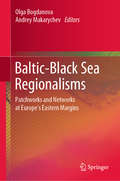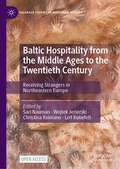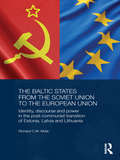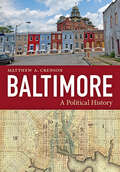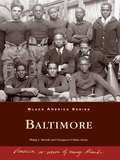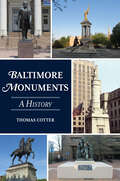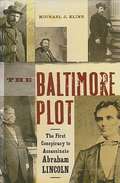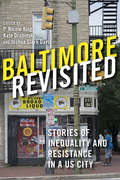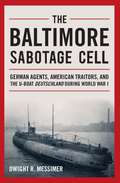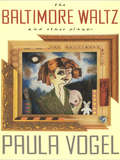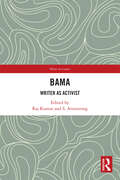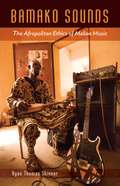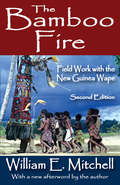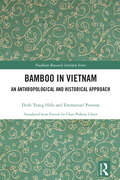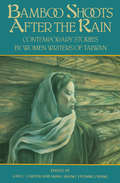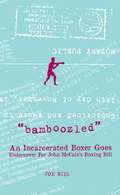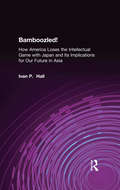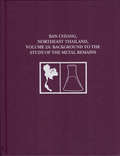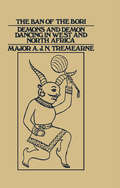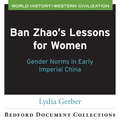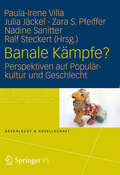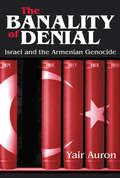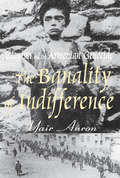- Table View
- List View
Baltic-Black Sea Regionalisms: Patchworks and Networks at Europe's Eastern Margins
by Olga Bogdanova Andrey MakarychevThis edited volume focuses on various forms of regionalism and neighborhoods in the Baltic-Black Sea area. In the light of current reshaping of borderlands and new geopolitical and military confrontations in Europe’s eastern margins, such as the annexation of Crimea and the war in Donbas, this book analyzes different types and modalities of regional integration and region-making from a comparative perspective. It conceptualizes cooperative and conflictual encounters as a series of networks and patchworks that differently link and relate major actors to each other and thus shape these interconnections as domains of inclusion and exclusion, bordering and debordering, securitization and desecuritization. This peculiar combination of geopolitics, ethnopolitics and biopolitics makes the Baltic-Black Sea trans-national region a source of inspiring policy practices, and, in the light of new security risks, a matter of increased concern all over Europe. The contributors from various disciplines cover topics such as cultural and civilizational spaces of belonging and identity politics, the rise of right-wing populism, region building under the condition of multiple security pressures, and the influence and regional strategies of different external powers, including the EU, Russia, and Turkey, on cross- and trans-regional relations in the area.
Baltic Hospitality from the Middle Ages to the Twentieth Century: Receiving Strangers in Northeastern Europe (Palgrave Studies in Migration History)
by Christina Reimann Wojtek Jezierski Sari Nauman Leif RunefeltReflecting debate around hospitality and the Baltic Sea region, this open access book taps into wider discussions about reception, securitization and xenophobic attitudes towards migrants and strangers. Focusing on coastal and urban areas, the collection presents an overview of the responses of host communities to guests and strangers in the countries surrounding the Baltic Sea, from the early eleventh century to the twentieth. The chapters investigate why and how diverse categories of strangers including migrants, war refugees, prisoners of war, merchants, missionaries and vagrants, were portrayed as threats to local populations or as objects of their charity, shedding light on the current predicament facing many European countries. Emphasizing the Baltic Sea region as a uniquely multi-layered space of intercultural encounter and conflict, this book demonstrates the significance of Northeastern Europe to migration history.
The Baltic Origins of Homer's Epic Tales: The Iliad, the Odyssey, and the Migration of Myth
by Felice VinciCompelling evidence that the events of Homer's Iliad and Odyssey took place in the Baltic and not the Mediterranean• Reveals how a climate change forced the migration of a people and their myth to ancient Greece • Identifies the true geographic sites of Troy and Ithaca in the Baltic Sea and Calypso's Isle in the North Atlantic OceanFor years scholars have debated the incongruities in Homer's Iliad and Odyssey, given that his descriptions are at odds with the geography of the areas he purportedly describes. Inspired by Plutarch's remark that Calypso's Isle was only five days sailing from Britain, Felice Vinci convincingly argues that Homer's epic tales originated not in the Mediterranean, but in the northern Baltic Sea. Using meticulous geographical analysis, Vinci shows that many Homeric places, such as Troy and Ithaca, can still be identified in the geographic landscape of the Baltic. He explains how the dense, foggy weather described by Ulysses befits northern not Mediterranean climes, and how battles lasting through the night would easily have been possible in the long days of the Baltic summer. Vinci's meteorological analysis reveals how a decline of the "climatic optimum" caused the blond seafarers to migrate south to warmer climates, where they rebuilt their original world in the Mediterranean. Through many generations the memory of the heroic age and the feats performed by their ancestors in their lost homeland was preserved and handed down to the following ages, only later to be codified by Homer in the Iliad and the Odyssey.Felice Vinci offers a key to open many doors that allow us to consider the age-old question of the Indo-European diaspora and the origin of the Greek civilization from a new perspective.
The Baltic States from the Soviet Union to the European Union: Identity, Discourse and Power in the Post-Communist Transition of Estonia, Latvia and Lithuania (BASEES/Routledge Series on Russian and East European Studies)
by Richard MoleThe Baltic States are unique in being the only member-states of the EU to have fought to regain their sovereignty from the Soviet Union, only then to cede it to Brussels in certain key areas. Similarly, no member-states have had to struggle as hard as Estonia, Latvia and Lithuania to preserve their identity after fifty years of Soviet nationality policy in the face of sub-state and supra-state challenges. The post-communist experience of the Baltic States thus allows us to examine debates about identity as a source of political power; the conditioning and constraining influence of identity discourses on social, political and economic change; and the orientation and outcome of their external relations. In particular, the book examines the impact of Russian and Soviet control of Estonia, Latvia and Lithuania; the Baltic independence movements of the late 1980s/early 1990s; the citizenship debates; relations with Russia vis-à-vis the withdrawal of the troops of the former Soviet Army; drawing of the shared boundary and the rights of Russian-speaking minorities as well as the efforts undertaken by the three Baltic States to rebuild themselves, modernise their economies, cope with the ensuing social changes and facilitate their accession to the EU and NATO.
Baltimore: A Political History
by Matthew A. CrensonHow politics and race shaped Baltimore's distinctive disarray of cultures and subcultures.Charm City or Mobtown? People from Baltimore glory in its eccentric charm, small-town character, and North-cum-South culture. But for much of the nineteenth century, violence and disorder plagued the city. More recently, the 2015 death of Freddie Gray in police custody has prompted Baltimoreans—and the entire nation—to focus critically on the rich and tangled narrative of black–white relations in Baltimore, where slavery once existed alongside the largest community of free blacks in the United States.Matthew A. Crenson, a distinguished political scientist and Baltimore native, examines the role of politics and race throughout Baltimore's history. From its founding in 1729 up through the recent past, Crenson follows Baltimore's political evolution from an empty expanse of marsh and hills to a complicated city with distinct ways of doing business. Revealing how residents at large engage (and disengage) with one another across an expansive agenda of issues and conflicts, Crenson shows how politics helped form this complex city's personality.Crenson provocatively argues that Baltimore's many quirks are likely symptoms of urban underdevelopment. The city's longtime domination by the general assembly—and the corresponding weakness of its municipal authority—forced residents to adopt the private and extra-governmental institutions that shaped early Baltimore. On the one hand, Baltimore was resolutely parochial, split by curious political quarrels over issues as minor as loose pigs. On the other, it was keenly attuned to national politics: during the Revolution, for instance, Baltimoreans were known for their comparative radicalism. Crenson describes how, as Baltimore and the nation grew, whites competed with blacks, slave and free, for menial and low-skill work. He also explores how the urban elite thrived by avoiding, wherever possible, questions of slavery versus freedom—just as wealthier Baltimoreans, long after the Civil War and emancipation, preferred to sidestep racial controversy. Peering into the city's 300-odd neighborhoods, this fascinating account holds up a mirror to Baltimore, asking whites in particular to reexamine the past and accept due responsibility for future racial progress.
Baltimore (Black America Series)
by Uluaipou-O-Malo Aiono Philip J. MerrillThroughout the years, the city of Baltimore has played host to many well-known figures, including Louis Armstrong, Duke Ellington, and boxer Joe Louis; the city has been called home by Billie Holiday, Frederick Douglass, and Thurgood Marshall. But it is the local African-American community's members, working diligently to advance and empower themselves, who made history while they lived it.
Baltimore Monuments: A History (History & Guide)
by Thomas CotterTour the monuments of the Monumental City.From its beginning as a small town on the banks of the Patapsco River in 1729, Baltimore has played a significant role in the development of the United States. To commemorate those persons or events that have contributed to the city and the nation's history, Baltimore was the first American city to build public monuments. Persons honored by these monuments have included artists, entertainers, athletes, civic leaders, government officials, military veterans, public servants, religious leaders, social reformers, and war heroes. Local historian Thomas Cotter discusses the history of each monument, its origin, notable designers, funding methods, dedication ceremony, and a description of the monument itself.
The Baltimore Plot: The First Conspiracy to Assassinate Abraham Lincoln
by Michael J. KlineIn January 1861, Abraham Lincoln¿s private train steamed from Illinois to Washington, D.C., where he would be inaugurated as the sixteenth President. However, in Baltimore, a group of Confederate conspirators had formed a plot to assassinate the President-in-waiting when his train made its final stop before Washington. When legendary detective Allan Pinkerton got wind of the plot, he advised Lincoln to remain hidden for the remainder of the journey while he conducted an investigation. However, the case was never brought to trial, leading Lincoln to be ridiculed in the press for cowardice because of which, he vowed never to hide in public again. A promise which, four years later when he sat in full view in the balcony of Ford's Theatre, would cost him his life.
Baltimore Revisited: Stories of Inequality and Resistance in a U.S. City
by Lawrence Brown Daniel L. Buccino Michael Casiano Sam Collins Shannon Darrow Matthew Durington Nicole Fabricant Aiden Faust Jennifer A. Ferretti Leif Fredrickson Robert Gamble Marisela Gomez April K. Householder Jodi Kelber-Kaye Louise Parker Kelley Emily Lieb Jacob R. Levin Teresa Méndez Ashley Minner Elizabeth M. Nix Richard E. Otten Eli Pousson Mary Rizzo Fred Scharmen Aletheia Hyun-Jin Shin Linda Shopes Michelle L. Stefano Joe Tropea Amy Zanoni Denise Meringolo Robert Headley Shawntay StocksNicknamed both “Mobtown” and “Charm City” and located on the border of the North and South, Baltimore is a city of contradictions. From media depictions in The Wire to the real-life trial of police officers for the murder of Freddie Gray, Baltimore has become a quintessential example of a struggling American city. Yet the truth about Baltimore is far more complicated—and more fascinating. To help untangle these apparent paradoxes, the editors of Baltimore Revisited have assembled a collection of over thirty experts from inside and outside academia. Together, they reveal that Baltimore has been ground zero for a slew of neoliberal policies, a place where inequality has increased as corporate interests have eagerly privatized public goods and services to maximize profits. But they also uncover how community members resist and reveal a long tradition of Baltimoreans who have fought for social justice. The essays in this collection take readers on a tour through the city’s diverse neighborhoods, from the Lumbee Indian community in East Baltimore to the crusade for environmental justice in South Baltimore. Baltimore Revisited examines the city’s past, reflects upon the city’s present, and envisions the city’s future.
The Baltimore Sabotage Cell
by Dwight R. MessimerBy the summer of 1915, Germany was faced with two related, but somewhat dissimilar problems; how to break the British blockade and how to stop or seriously disrupt the British supply line across the Atlantic. The solution to breaking the blockade was to find a way over it, through it, or under it. Aircraft in those days were too primitive, underpowered, and short range to accomplish the first and Germany lacked the naval strength to force a passage through the blockade. But if a fleet of cargo U-boats could be built that were large enough to carry meaningful loads and had the range to make a round trip between Germany and the United States without having to refuel, the blockade might be successfully broken. Responsibility for implementing this solution rested with a section of German Navy Intelligence known as the Etappendienst. The Germans also lacked the naval strength to effect the solution to the other problem; cutting Britain's supply line to America. The German Navy could not defeat the Royal Navy in a slug-fest and there were not enough U-boats to effectively block Britain's cross-Atlantic sea trade. The answer lay in sabotage--blowing up the munitions factories, the depots, and the ships, and infecting the remounts--horses and mules--with Anthrax and Glanders at the western end of the supply line. Responsibility for carrying out sabotage of all types in the United States rested with a newly established subsection of the German Army Intelligence called the Sektion Politik that sent trained saboteurs to the United States beginning in 1915. German agents, together with American sympathizers, carried out more than fifty successful attacks involving fire and explosion before America's entry into the war on 6 April 1917, in addition to spreading Anthrax and Glanders on the East Coast. Of the two solutions to those problems, sabotage was incompatible with Germany's primary diplomatic goal to keep the United States out of the war, while the other, breaking the blockade with a fleet of cargo U-boats, provided the least danger of bringing the United States into the war. The two solutions were widely dissimilar, but the fact that the cargo U-boat project and the sabotage campaign were run by intelligence agencies--the Etappendienst (Navy) and the Geheimdienst (Army), through the agency of one man--Paul Hilken, in one US city--Baltimore, make them inseparable. Those separate solutions created the dichotomy that produced the U-Boat Deutschland and the Baltimore Sabotage Cell.
The Baltimore Waltz and Other Plays
by Paula VogelThe Baltimore Waltz, Vogel's most personal play, centers around the memory of a loved one lost to AIDS; the other plays include, Desdemona, The Oldest Profession, And Baby Makes Seven, and Hot 'n' Throbbing.
Bama: Writer as Activist (Writer in Context)
by Raj Kumar and S. ArmstrongBama is a Tamil Dalit feminist writer and novelist. Her autobiographical novel Karukku, which chronicles the joys and sorrows experienced by Dalit Christians in Tamil Nadu, catapulted her to fame. As a prolific writer, she has experimented with all kinds of genres, such as novels, short stories, poems, autobiographical writing, children’s literature, and discursive essays. This book presents a dedicated study of Bama’s work as a writer and activist and situates her in the context of Dalit literature in general and Tamil Dalit literature in particular. It recognises Bama as writer of great relevance especially in bringing to the fore the problematics of Dalit issues and their possible modes of aesthetic articulation through a new Dalit language.Part of the Writer in Context series, this book will be useful for scholars and researchers of Indian literature, Dalit Literature, Dalit Studies, Tamil literature, English literature, comparative literature, postcolonial studies, cultural studies, Green studies. global south studies and translation studies.
Bamako Sounds: The Afropolitan Ethics of Malian Music (A Quadrant Book)
by Ryan Thomas SkinnerBamako Sounds tells the story of an African city, its people, their values, and their music. Centered on the music and musicians of Bamako, Mali&’s booming capital city, this book reveals a community of artists whose lives and works evince a complex world shaped by urban culture, postcolonialism, musical expression, religious identity, and intellectual property.Drawing on years of ethnographic research with classically trained players of the kora (a twenty-one-string West African harp) as well as more contemporary, hip-hop influenced musicians and producers, Ryan Thomas Skinner analyzes how Bamako artists balance social imperatives with personal interests and global imaginations. Whether performed live on stage, broadcast on the radio, or shared over the Internet, music is a privileged mode of expression that suffuses Bamako&’s urban soundscape. It animates professional projects, communicates cultural values, pronounces public piety, resounds in the marketplace, and quite literally performs the nation. Music, the artists who make it, and the audiences who interpret it thus represent a crucial means of articulating and disseminating the ethics and aesthetics of a varied and vital Afropolitanism, in Bamako and beyond.
The Bamboo Fire: Field Work with the New Guinea Wape
by William E. MitchellAnthropology is primarily done in the field, unlike the laboratory oriented experimental sciences. Experimental sciences make their observations in constructed settings that permit variables influencing the outcome of the experiment to be known and controlled. In contrast, anthropology's object of inquiry, like the science of ethology is life experience in its natural setting. To understand how people organize their lives both in thought and in action, one must settle among them for a very long time.The Wape of Papua New Guinea inhabit a mountainous rain forest and live in sedentary villages. They are slash and burn horticulturalists. marriage is by bride wealth and polygyny is permitted but rare. Male status is egalitarian and, although the society is hierarchical in terms of sex and age differences, both women and the young enjoy higher status than in many other New Guinea societies. While most Wape are nominal Christians, traditional religious beliefs and practices are of major importance.This book concentrates on describing the field work process by giving the reader a feeling of the reflexive nature of this experience. It demonstrate not only how the anthropologist proceeds in her or his work, but describes the social and psychological context in which that work evolves and how anthropologists respond to it both within oneself and in communication with others. While it is a book about the Wape people it is also a book about how one anthropologist tried to understand them. It integrates the subjective and objective into a common research method. Related to the book, the author has published a film, Magical Curing, and a CD, The Living Dead and Dying: Music of the New Guinea Wape.
Bamboo in Vietnam: An Anthropological and Historical Approach (Needham Research Institute Series)
by Đinh Trọng Hiếu Emmanuel PoissonThis book presents interdisciplinary research on bamboo in Vietnam, drawing on the anthropology of gesture, ethnobotany and the history of technology. The authors have adopted a technological approach which reviews how the terminology of different parts of the bamboo plant in the dictionaries in Romanized Vietnamese or in Vietnamese vernacular writing (nôm) enabled the authors to identify not only the plant but also each technical gesture for its appropriation by the artisan. Lithographic, literary and historical sources from the chronicles have been mobilized to illustrate the many uses of this versatile plant. Richly illustrated throughout, this book will appeal to students and scholars of Vietnam, anthropology, the history of science and technology, environmental history and architecture. It will also be of great value to those interested in the applications of bamboo in the contemporary world.
Bamboo Shoots After the Rain: Contemporary Stories by Women Writers of Taiwan
by Ann C. Carver, Sung-sheng Yvonne ChangA short story collection hailed as a &“welcome and valuable addition to our growing knowledge about the inner lives and literary talents of Chinese women&” (Amy Ling, author of Between Worlds: Women Writers of Chinese Ancestry). This remarkable anthology introduces the short fiction of fourteen writers, major figures in the literary movements of three generations, who represent a range of class, ethnic, and political perspectives. It is filled with unexpected gems such as Lin Hai-yin&’s story of a woman suffering under the feudal system of Old China, and Chiang Hsiao-yun&’s optimistic solutions to problems of the elderly in rapidly changing 1980s Taiwan. And in between, a dozen rich stories of aristocrats, comrades, wives, concubines, children, mothers, sexuality, female initiation, rape, and the tensions between traditional and modern life. &“This is not western feminism with an Asian accent&”, says Bloomsbury Review, &“but a description of one culture&’s reality. . . . The woman protagonists survive both despite and because of their existence in a changing Taiwan.&”
Bamboozled
by Joe Biel Joey TorreyIn this introspective exploration of former boxer Joey Torrey's life, his past, his murder conviction, and his more than 30-year incarceration in a California state prison are each fine-tooth combed. Nearly five years after his original memoir, this new edition is re-written as a biography and delves deeper into circumstances surrounding Torrey's alleged murder of his boxing coach, the lengthy prison sentence handed down, his undercover collaboration with the FBI on "Operation Matchbook" in support of John McCain's proposed Professional Boxing Amendments Act, and the inner workings of the prison system in general. From his days as a Compton gang leader and an Olympic boxing hopeful to being tried as an adult rather than a 17-year-old minor, this compelling narrative reflects on his life as a parable as well as examining the strategies used in his conviction, such as establishing the motive as robbery despite a lack of evidence linking the opening of safe to the murderer. And after more than three decades as a model prisoner-and saving the life of a prison guard-Torrey has prolifically written hundreds of letters to Joe Biel, who finds himself in the unlikely situation to share this story.
Bamboozled!: How America Loses the Intellectual Game with Japan and Its Implications for Our Future in Asia
by Ivan P. HallAs the influence of the United States in Asia declines with the end of the Cold War, America must look more to brains than military might in achieving our objectives in the region. But after repeatedly allowing Japan - our closest ally in Asia - to mislead us intellectually and psychologically, how well are we prepared to deal with less friendly emerging powers like China and India? Based on three decades of on-the-spot observation and participation in Japan, Ivan Hall's provocative work draws the reader into a world of intellectual manipulation and gullibility, false images, emotional blackmail, financial beguilement, and fatuous expectations. It illuminates the many ways that American ideological hubris and Japanese pleading for special treatment combine to deprive our trans-Pacific dialogue of the honesty, openness, and plain common sense of our trans-Atlantic intellectual ties with Europe.
Ban Chiang, Northeast Thailand, Volume 2A: Background to the Study of the Metal Remains
by Joyce C. White Elizabeth G. HamiltonThe emergence and adoption of metallurgy is one of the seminal topics of investigation in the history of archaeology, particularly in the history of archaeological research in Southeast Asia. The site of Ban Chiang, Thailand, is a central site in debates surrounding the chronology and significance of early metallurgy in the region. This book is the first in a series of four volumes that review the contributions of Ban Chiang and three related sites in northeast Thailand excavated by the Penn Museum to an understanding early metallurgy in Thailand.As the study of archaeometallurgy is a complex topic that draws on numerous technical and social science disciplines, this introductory volume presents in several chapters the background needed to assess the metal and related evidence presented in the subsequent volumes in this series. A history of perspectives on the role of metals in ancient societies generally and Southeast Asia, specifically, is provided. Other chapters debunk the conventional paradigm for understanding metals and society and provide current theoretical perspectives and new paradigms for the study of ancient metals. The geological basis for the presence and location of metal ore resources in the region is reviewed. The final chapter presents a technical overview of ways material properties of ancient metals may be studied. While providing a background to the study of metals at Ban Chiang, the volume also reviews, synthesizes, and repositions the method and theory for the study of archaeometallurgy generally.Thai Archaeology Monograph Series, 2A; University Museum Monograph, 149
Ban of the Bori: Demons and Demon-Dancing in West and North Africa
by Major A.J.N. TremearneFirst Published in 1968. Routledge is an imprint of Taylor & Francis, an informa company.
Ban Zhao’s Lessons for Women: Gender Norms in Early Imperial China (Bedford Document Collection )
by Lydia GerberThis document collection will allow students to gain a deeper understanding of the challenges and opportunities marriage presented to women and families in Early Imperial China by assessing the contents of Ban Zhao's text. Students are guided through their analysis of the primary sources with an author-provided learning objective, central question, and historical context.
Banale Kämpfe?: Perspektiven auf Populärkultur und Geschlecht (Geschlecht und Gesellschaft #51)
by Zara Pfeiffer Ralf Steckert Julia Jäckel Paula-Irene Villa Nadine SanitterWie inszeniert Lady Gaga Weiblichkeit über ihre Haarpracht? Warum schreiben Frauen* ,schwulen Porn'? Ist Jack Bauer ein tragischer Held? Können Geschlechterverhältnisse in der Populärkultur kritisch unterlaufen werden? Auseinandersetzungen mit Popula rkulturen sind von kontroversen Sichtweisen gepra gt, die vor allem in der Frage nach affirmativen und subversiven Momenten sichtbar werden. Interdependente Geschlechterverhältnisse spielen in diesen Diskussionen eine zentrale Rolle. Der Sammelband präsentiert Beitra ge aus den Sozial- und Geisteswissenschaften, die diese Auseinandersetzung führen.
The Banality of Denial: Israel and the Armenian Genocide
by Julian SimonThe Banality of Denial examines the attitudes of the State of Israel and its leading institutions toward the Armenian Genocide. Israel's view of this issue has special significance and deserves an attentive study, as it is a country composed of a people who were victims of the Holocaust. The Banality of Denial seeks both to examine the passive, indifferent Israeli attitude towards the Armenian Genocide, and to explore active Israeli measures to undermine attempts at safeguarding the memory of the Armenian victims of the Turkish persecution.Such an inquiry into attempts at denial by Israeli institutions and leading figures of Israel's political, security, academic, and Holocaust "memory-preservation" elite has not merely an academic significance. It has considerable political relevance, both symbolic and tangible.In The Banality of Denial--as in Auron's previous work--moral, philosophical, and theoretical questions are of paramount importance. Because no previous studies have dealt with these issues or similar ones, an original methodology is employed to analyze the subject with regard to four domains: political, educational, media, and academic.
The Banality of Indifference: Zionism and the Armenian Genocide
by Yair AuronThe genocide of Armenians by Turks during the First World War was one of the most horrendous deeds of modern times and a precursor of the genocidal acts that have marked the rest of the twentieth century. Despite the worldwide attention the atrocities received at the time, the massacre has not remained a part of the world's historical consciousness. The parallels between the Jewish and Armenian situations and the reactions of the Jewish community in Palestine (the Yishuv) to the Armenian genocide, which was muted and largely self-interested, are explored by Yair Auron. In attempting to assess and interpret these disparate reactions, Auron maintains a fairminded balance in assessing claims of altruism and self-interest, expressed in universal, not merely Jewish, terms.While not denying the uniqueness of the Holocaust, Auron carefully distinguishes it from the Armenian genocide reviewing existing theories and relating Armenian and Jewish experience to ongoing issues of politics and identity. As a groundbreaking work of comparative history, this volume will be read by Armenian area specialists, historians of Zionism and Israel, and students of genocide. Yair Auron is senior lecturer at The Open University of Israel and the Kibbutzim College of Education. He is the author, in Hebrew, of Jewish-Israeli Identity, Sensitivity to World Suffering: Genocide in the Twentieth Century, We Are All German Jews, and Jewish Radicals in France during the Sixties and Seventies (published in French as well)
Bananas
by Virginia JenkinsBefore 1880 most Americans had never seen a banana. By 1910 bananas were so common that streets were littered with their peels. Today Americans eat on average nearly seventy-five per year. More than a staple of the American diet, bananas have gained a secure place in the nation's culture and folklore. They have been recommended as the secret to longevity, the perfect food for infants, and the cure for warts, headaches, and stage fright. Essential to the cereal bowl and the pratfall, they remain a mainstay of jokes, songs, and wordplay even after a century of rapid change.Covering every aspect of the banana in American culture, from its beginnings as luxury food to its reputation in the 1910s as the "poor man's" fruit to its role today as a healthy, easy-to-carry snack, Bananas provides an insightful look at a fruit with appeal.
